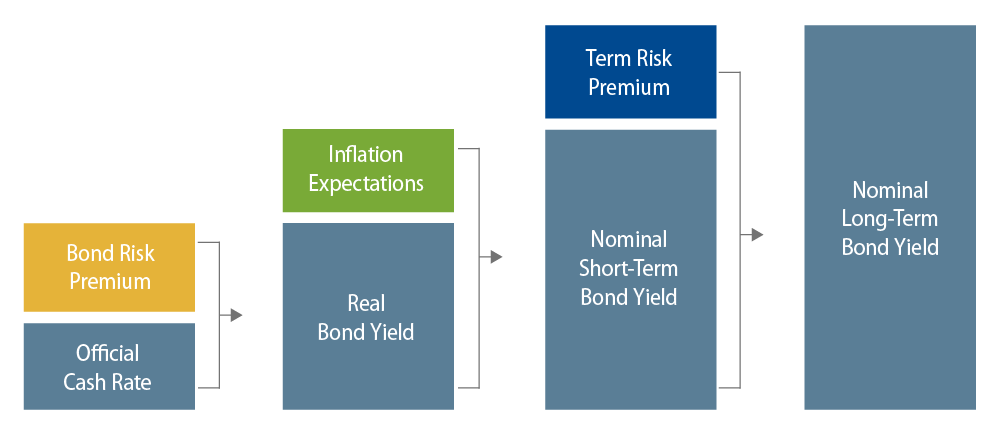
Executive Summary
- Understanding the drivers of bond returns can help manage both risk and return expectations.
- Real bond returns depend primarily on two factors: the ability of issuers to meet their obligations and the rate of inflation.
- Bond investors in Australia should also consider the Official Cash Rate (OCR), bond risk premiums and term risk premiums.
- Western Asset’s large global fixed-income investment team actively positions the Western Asset Australian Bond strategy where we see the most attractive risk-adjusted returns across the curve.
The multi-year global bond rally has some market commentators setting high risk and low return expectations for Australian fixed-income markets. This picture is normally based on scenarios where rates increase across the curve, from the Reserve Bank of Australia’s (RBA) cash rate to longer maturities.
To set risk and return expectations for the bond market we must first understand the drivers of bond returns. From this starting point, investors can begin to understand what the likely impact of future changes in interest rates will have on bond market performance.
The Building Blocks of Bond Returns
Owners of bonds are promised a fixed cash flow in nominal terms. Therefore, their real return will depend on the issuer’s ability to meet their obligations and the rate of inflation, which erodes purchasing power over the life of the investment. Accordingly, investors will demand a level of compensation based on their expectations, which can be separated into four theoretical components.
Building Blocks of Bond Returns

- Official Cash Rate (OCR): the rate of interest that RBA charges on overnight loans to commercial banks, which serves as the primary tool through which the RBA influences the economy.
- Bond Risk Premium: the additional return required for an investor to hold a bond. This will include the creditworthiness of the issuer (which includes risks associated with a sovereign issuer such as Australia), interest rate sensitivity (if yields rise, the price will fall), supply and demand dynamics, and other technical factors such as price insensitive buyers (central banks).
- Inflation Expectations: provide compensation for the potential future decrease/or increases in purchasing power of the original investment.
- Term Risk Premium: investors generally see greater risk in lending for longer periods than for short periods.
While it is useful conceptually to think about these components, they are not readily observable and must be inferred. Therefore, it is difficult to identify the exact changes of each factor, although some clarity can be gained from market instruments such as inflation-linked bonds and forward-rate pricing.
What Does a Yield Curve Tell Us?
We can appreciate why many people tune out when someone mentions the yield curve. But it is normal for people to visualise a smooth upward sloping line as investors are compensated for term risk and increasing inflation expectations through time.
However, this is not always the case. The yield curve is a graphic illustration showing the yields on bonds at various maturities; depending on the expectation for future interest rate moves, it can at times be flat or even inverted and it often displays kinks, or steep sections, and can resemble a Nike swoosh.
This is because when rates move materially, they rarely move in a perfectly parallel fashion. This is due to the numerous factors that drive the individual building blocks of returns. For example, when the OCR increases, this will normally decrease inflation expectations into the future, holding down long-term bond yields and resulting in a flatter yield curve.
While the yield curve often contains noise due to technical factors such as foreign ownership or index inclusions, which can overpower fundamental expectations, over the long-term it has been a good predictor of economic output. So much so, in fact, that the Federal Reserve of Cleveland uses the spread between the three-month and 10-year key rates as a predictive input into their recession probability model.
Historically, the inversion of the US yield curve has preceded each of the last seven US recessions and the curve flattened materially ahead of the weak growth period of 1998 (not a technical recession). In Australia, we have not experienced a recession for over 25 years, but an inverted curve has been a good indicator of falling economic growth. The curve also flattened during the two most recent RBA tightening cycles starting in 2007 and 2009.
Given that increasing short-term interest rates are intended to take some steam out of the economy and reduce inflationary pressures, it is not so surprising that yield curves generally flatten during periods of rising cash rates especially towards the end of the tightening cycles. This raises the question of whether long-term bond rates will increase materially during the current rate hiking cycle or whether this will be another example of a flattening yield curve as investors fear the contractionary impact of higher cash rates.
The Final Touch
Western Asset draws upon the significant depth of insight from one of the largest global fixed-income investment teams to actively position the Western Asset Australian Bond strategy where we see the most attractive risk-adjusted returns across the curve.
Looking forward we anticipate that the current moderate growth environment will continue, with limited wage inflation pressures resulting in a low probability of Australian cash rates or longer maturity bonds moving materially higher in the next 12 months.


